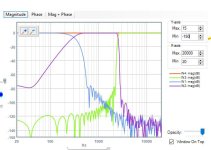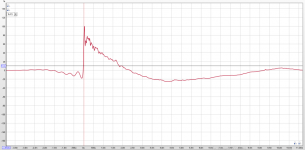Hi Everyone!
It's been a while since I seriously engaged this forum, so hope you'll be kind. I wanted to let the DIY community know I successfully completed a 3-way center channel using ScanSpeak drivers and a Hypex plate amplifier along with some lessons learned. I have a modest 5.1 home theater. Because of the room dimensions I sit about 10' away from the stereo but often at an angle. I wanted something relatively small to fit on top of an entertainment center with excellent off-axis response and excessive dynamic range. What I did not need was deep bass. This was always going to be a satellite center.

Let me start with the measurements. These are taken with the speaker in place. The red line is on-axis, green is 45 degrees horizontally, and black is 45 degrees above axis.

The curve matches my side speakers, but the 80 Hz high pass function is half in the processor, half in the Hypex DSP.
The components:
This was my first active design and I think what I liked most about it was being able to make a crossover without compromise. That is, it was straightforward to implement LR4 and the matching delays needed. I honestly don't have the chops to have done all of this with a passive crossover. The other thing I really like is optimal power balancing. The woofers get as much power as they are rated for and so does the midrange without wasting anything in resistors or using an excessively large linear amplifier.
Please let me know what you think and if you have any questions.
It's been a while since I seriously engaged this forum, so hope you'll be kind. I wanted to let the DIY community know I successfully completed a 3-way center channel using ScanSpeak drivers and a Hypex plate amplifier along with some lessons learned. I have a modest 5.1 home theater. Because of the room dimensions I sit about 10' away from the stereo but often at an angle. I wanted something relatively small to fit on top of an entertainment center with excellent off-axis response and excessive dynamic range. What I did not need was deep bass. This was always going to be a satellite center.
Let me start with the measurements. These are taken with the speaker in place. The red line is on-axis, green is 45 degrees horizontally, and black is 45 degrees above axis.
The curve matches my side speakers, but the 80 Hz high pass function is half in the processor, half in the Hypex DSP.
The components:
- Hypex FA123 3-way plate amp
- Tweeter: SS Illuminator D3004-662000
- Midrange: SS Illuminator 12MU-8731T00
- Woofers: Revelator 18W-8531G00
- Cabinet: Solen custom 24" x 10" x 12" (really excellent work BTW)
- 350 Hz
- 3000 kHz
This was my first active design and I think what I liked most about it was being able to make a crossover without compromise. That is, it was straightforward to implement LR4 and the matching delays needed. I honestly don't have the chops to have done all of this with a passive crossover. The other thing I really like is optimal power balancing. The woofers get as much power as they are rated for and so does the midrange without wasting anything in resistors or using an excessively large linear amplifier.
Please let me know what you think and if you have any questions.
Last edited:
It is very interesting to look at the step response at the listening point.Crossovers are LR4 with digital delay on the mid and tweeter.
Yes, this is a big plus. Another thing I like is being able to quickly evaluate small changes. If you want to lower the tweeter level by 1 dB, or make a small change in EQ somewhere, it is as simple as running a USB cable from a laptop to the Hypex amp. Then with a push of a button, you can listen to the before and after version... I really like that aspect.This was my first active design and I think what I liked most about it was being able to make a crossover without compromise.
Nice job!
Have you tried listening to LR2 at 350? Over time, I have found I prefer the sound of 2nd order filters over 4th order, when the crossover is below 500 Hz. But we all hear things differently.
j.
@uriy-ch I'm afraid I have taken down my measurement rig, the best I can do for you right now is reverse engineer it by feeding XSim the FR and phase and letting it generate an appropriate step response. Again, this is in room, on entertainment center so I'm not expecting it to be great. What do you think? :

I just don’t understand why people with DSP use IIR division. To my hearing, dividing the bands without phase shifts gives the sound greater intelligibility, the sound becomes more cohesive, the sound becomes more similar in intelligibility to the sound in headphones.What do you think? :
Have you tried dividing the frequency using FIR or subtractive crossover?
Have you tried dividing the frequency using FIR or subtractive crossover?
@uriy-ch - I used whatever Hypex gives me. 🙂
I'm not sure if the Hypex plate amps have provision for FIR. If they did, the user would need to understand the limits of a certain number of taps and delay between them. It might cause sync issues on multi-channel systems. It might be more trouble than Hypex want to bother with.
A phot of the speaker rather than the TV might be nice 🙂
A phot of the speaker rather than the TV might be nice 🙂
A phot of the speaker rather than the TV might be nice 🙂
How is this, @Tenson? The tweeter looks a little weird, it's just a lighting effect.
The primary reason that people would use IIR filtering is because the equipment they have chosen does not support FIR, and they have a strong justification for using their chosen equipment in spite of the lack of FIR capability. A secondary reason is to minimize latency, although in most cases latency is not a problem.I just don’t understand why people with DSP use IIR division.
Most modern DSPs support FIR, but people somehow don’t want to use them. FIR makes it very easy to match speakers that cannot play well beyond the crossover frequency. FIR makes a steep decline in the frequency response, but does not rotate the phase, this allows you to match the speaker at the frequency without problems. This is a very good advantage that people don’t want to take advantage of...
If you are happy with the sound as it is, then you don’t need to change anything. I don’t insist, I’m just curious why people choose IIR when FIR allows you to configure speakers with a smaller phase shift of the bands.I'm sorry that my impulse response is not what you wanted to see @uriy-ch but in my case I think it sounds ideal as-is.
, I’m just curious why people choose IIR when FIR allows you to configure speakers with a smaller phase shift of the bands.
In my case it's at least partly because I'm coming from passive speaker design and I was not aware of significant differences. I didn't even know I had a choice. Latency is a big deal though so if there's any chance of adding significant time to the speaker I'd rather avoid it in case I run up against the limits of my HT processor. Some of it is also that I was exposed to LR crossovers in the late 1980's as part of the THX theater program and I always wanted to design and build a speaker using those principles.
What I am most surprised at is the delay settings don't make sense based on what I had read. My memory (which is poor) was that LR4 was best implemented with drivers that were time aligned. That is, in a 2-way, you'd push the tweeter away from the listener such that the acoustic center was aligned with the woofer, and then implement LR4 electro-acoustically, and voila, instant phase alignment. This did not happen here. In fact the tweeter has the least delay, then the midrange. So clearly there is something going on with the phase alignment that I did not expect.
Last edited:
- Home
- Loudspeakers
- Multi-Way
- A successful ScanSpeak + Hypex Center

